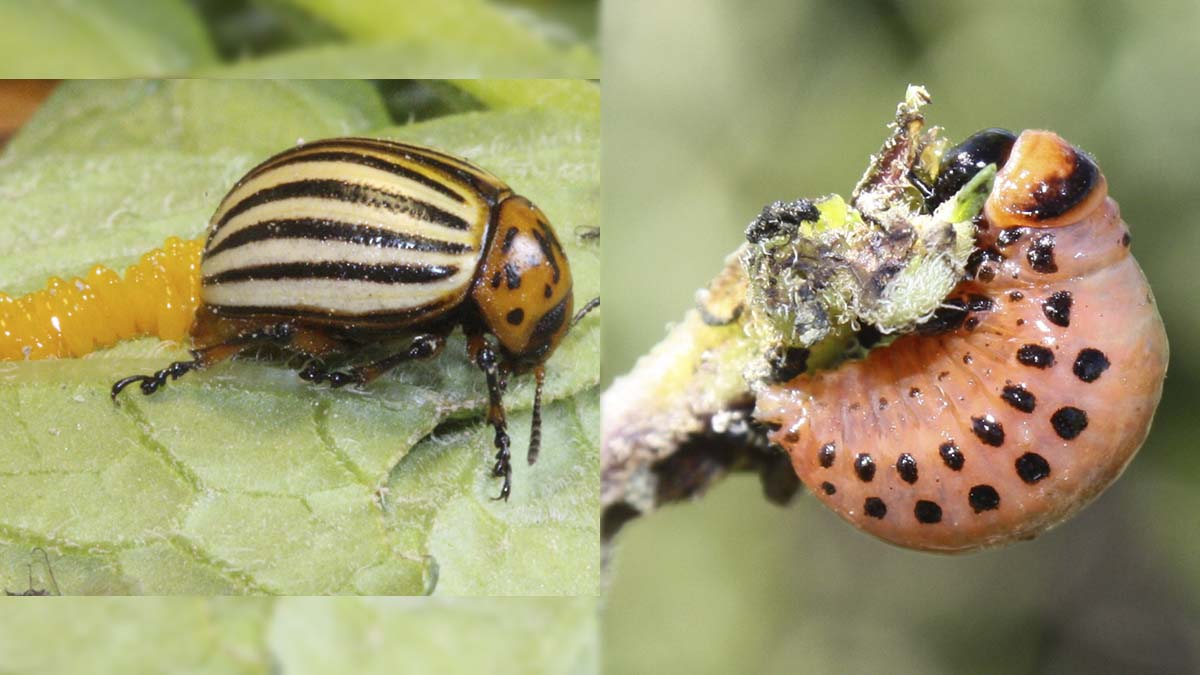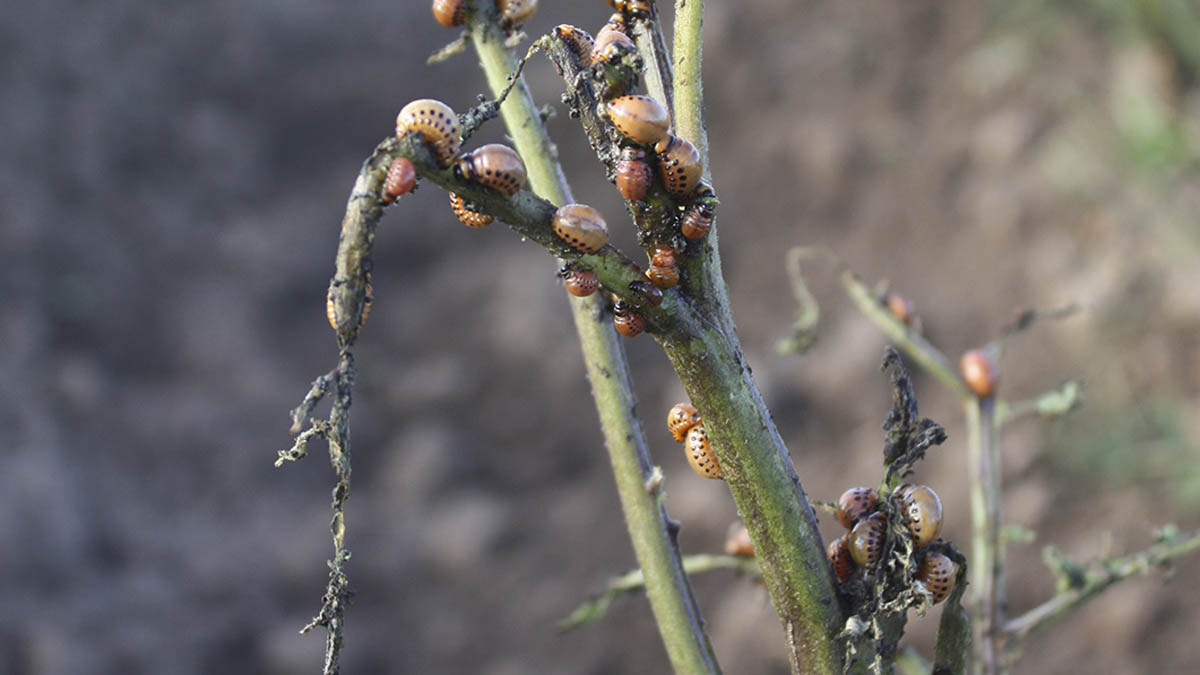Colorado Potato Beetle
Pest Common Name
- Colorado Potato Beetle (Leptinotarsa decemlineata)
- Potatoes
- Cultivated nightshades, including tomato, pepper and eggplant
- Nightshade weeds, including hairy nightshade
Adult Colorado Potato Beetles (CPB) are large, conspicuous insects in the family Chrysomelidae, commonly known as the leaf beetles. CPB feed exclusively on solanaceous plants (nightshade family). They are about 3/8 inch (9.5 mm) long, with yellow, rounded and convex wing covers (elytra) marked with ten black stripes. CPB eggs are orange to yellow and laid in clusters of about 25-30 on the underside of leaves. Larvae progress through four instars (stages), ranging in size from 1/8 to 1/2 (3-13 mm) in long. Early instar larvae are dark red with a black head. Later instar larvae have a black head and a slug-like, humped body; they are soft-skinned, brick red to orange or even pink, with two rows of black spots on each side of their bodies (Figure 1).

Biology
In Idaho, adult beetles overwinter buried 4-10 in (10-25 cm) in the soil. Adults emerge in the spring around the time of emergence of the first volunteer potatoes and begin feeding on volunteer potatoes or weed hosts before dispersing to potato fields. Adult beetles may feed for up to a week before laying eggs, depending on the temperature. Females may lay 300-800 eggs over a 4-5-week period.
Eggs hatch in 4-9 days, depending on temperature. Young larvae remain close to the egg mass from which they hatched but begin to disperse as they consume the foliage. The larvae develop through four growth stages in as little as 8-10 days. The fourth and final growth stage takes three times as long as the other three stages combined.
The mature larvae drop from the plant and burrow into the soil where they pupate and emerge as adults in 1-2 weeks. Adults of this new summer generation emerge and lay eggs within the same field or in nearby fields. Beetles may exhibit one to three overlapping generations per year, depending on climate and temperature. In most potato-growing regions of Idaho, two generations are common. Individuals from the last adult generation disperse to overwintering sites.
Damage
Foliar feeding by larvae and adults can reduce plant health and feeding on fruits can cause direct damage. Larvae can consume about four times more leaf mass than do adults; therefore, feeding by larvae is more damaging than feeding by adults. Eggplants can tolerate around 30% defoliation without yield loss, though tolerance to defoliation may vary among cultivars.

Monitoring
Starting at crop emergence, scout plants weekly or every three to four days during periods where rapid population growth is likely such as when eggs are hatching or when numbers approach economic thresholds (see thresholds below). One recommended way to monitor is to count different life stages on plants (if plants are less than 18 inches (46 cm) tall) or stalks if it is later in the season and plants are larger. Examine both foliage and stems/stalks, though larvae generally feed toward the tops of plants and are often easily spotted. Count adult beetles, large larvae (greater than 1/3 in), small larvae (less than 1/3 in) and egg masses separately. Also take note of percent defoliation. Calculate the average number of each life stage and the average percent defoliation. There are no formal economic thresholds that apply to all areas and host plants, but in general if defoliation exceeds 10-15% or if CPB reach certain numbers (see thresholds below), a foliar insecticide application may be warranted.
Thresholds for Colorado potato beetle larvae on eggplant plants of different sizes*:
- Less than 6 inches tall — Large larvae (greater than 1/3 inch) 1 per plant
- Less than 6 inches tall — Small larvae (less than 1/3 inch) 2 per plant
- Greater than 6 inches tall — Large larvae (greater than 1/3 inch) 2 per plant
- Greater than 6 inches tall — Small larvae (less than 1/3 inch) 4 per plant
*These values should be used only for guidance.
Management
Primary Management Tactics
Crop rotation and eliminating alternative host plants can help reduce CPB movement into crop fields. When chemical control is necessary, it is best to treat when larvae are small, and thus most susceptible to pesticides. In areas where CBP are a problem every year, at-plant insecticides may be best; otherwise, foliar insecticides should be applied based on scouting. Large larvae inflict the most feeding damage, so managing CPB before problematic numbers of larvae reach this stage is key.
Physical*
- Plastic-lined trench traps, propane flamers and vacuums can physically remove beetles
- *Note: These tactics are rarely used by commercial growers given their high cost and labor inputs
Cultural
- Crop Rotation — Crop rotation helps to delay or reduce beetle pressure, though space limitations on your property may limit the extent to which this tactic can be used. By planting as far as possible from last year’s susceptible hosts (at least 330 yards to 0.5 mile is preferable), the number of beetles that disperse to the current year’s plants may be reduced greatly.
- Elimination of Alternative Hosts — Several herbaceous weeds, including those in the same family as potatoes, tomatoes and eggplants (nightshades), serve as alternative hosts for CPB (and other pests of nightshades, including some aphids). Elimination of these alternative hosts can reduce the presence of CPB in the crop.
- Maintain Healthy Plants — Healthy, vigorous plants are better able to withstand feeding injury
- Other Cultural Control Methods — There are numerous other cultural controls that may be used to reduce damage from CPB. For example, beetle pressure may be reduced by adjusting planting date, using trap crops or applying mulches. Little research has been conducted in Idaho to confirm that these approaches work in our area.
Biological
- The pathogenic fungus Beauveria bassiana attacks Colorado potato beetles; it is available commercially and may reduce beetle populations by up to 75%
- Limiting use of broad-spectrum insecticides can help foster populations of beneficial arthropods such as:
- Lady beetles, ground beetles, predatory stink bugs, harvestmen (daddy longlegs) and spiders
- Certain wasps and tachinid flies parasitize CPB and may reduce beetle pressure considerably; however, these parasitoids cannot overwinter in temperate climates
Chemical
- Spinosad and neem products are effective organic insecticides for controlling larval stages
- Sprays applied when most larvae have hatched and are still in the first or second instar will maximize effects on these more susceptible stages
- Where damaging infestations of CPB are not an annual occurrence, the best option for control is to scout the crop regularly after emergence and apply foliar insecticides as needed
- Under lower pressure situations, spot treatment of areas with high beetle density is often sufficient
- In areas where CBP are a problem every year, a preventive application of a systemic insecticides may be best, as successful management of the first generation of beetles greatly reduces the likelihood that further management will be necessary
- Rotation among insecticides with different modes of action is important to prevent insecticide resistance, which can develop rapidly in CPB
- For registered chemical control options for Colorado Potato Beetles, please refer to the PNW Insect Management Handbook for eggplant and for tomato
Pesticide Warning
Always read and follow the instructions printed on the pesticide label. The pesticide recommendations in this University of Idaho webpage do not substitute for instructions on the label. Pesticide laws and labels change frequently and may have changed since this publication was written. Some pesticides may have been withdrawn or had certain uses prohibited. Use pesticides with care. Do not use a pesticide unless the specific plant, animal or other application site is specifically listed on the label. Store pesticides in their original containers and keep them out of the reach of children, pets and livestock.
Trade Names — To simplify information, trade names have been used. No endorsement of named products is intended nor is criticism implied of similar products not mentioned.
Groundwater — To protect groundwater, when there is a choice of pesticides, the applicator should use the product least likely to leach.
- Erik J. Wenninger, University of Idaho
Desiree Wickwar, Entomologist, IPM Project Manager
Erik J. Wenninger, Professor of Entomology, IPM Coordinator
2023








